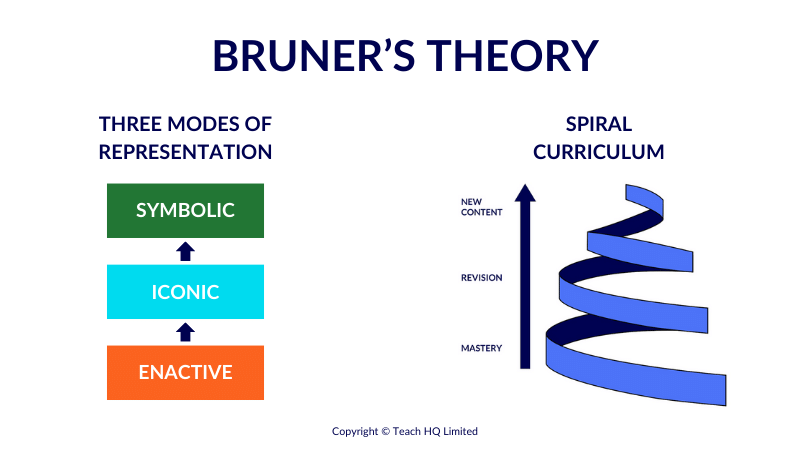American psychologist Jerome Bruner helped to shape a generation of teaching methodologies. In fact, he could be considered an icon in cognitive psychology! He brought to the table some very keen insights into how we learn. Notable in Bruner’s work was his three modes of representation theory. This provided educators with a roadmap to understand the evolving nature of a child's grasp of knowledge. His theory of a spiral curriculum added to and built upon this. Unpacking both the 'what' of learning and the 'how', Bruner’s approach offered a fresh lens on the developmental stages of understanding. For educators, tapping into these modes helps in curating lessons that effectively guise each student on their learning journey. Let’s take a look at what the three modes, the spiral curriculum, and how they intertwine (so to speak).
The Three Modes of Representation
Enactive Representation (0-1 years)
Enactive representation is the dawn of a child's learning journey. The name is rooted in the Latin word 'enactus', meaning 'enacted'. This mode revolves around the tangible, the direct, and the concrete. It's all about action and interaction. The process of learning for a very young child is more about 'doing' and 'experiencing'. Everything is an opportunity: clutching a soft toy, shaking a rattle, or navigating the first crawl can all embed memories not through words or pictures but through tactile experiences. Direct hands-on interaction is essential, as understanding is moulded by touch, motion, and direct manipulation. This is the foundation upon which all subsequent learning builds. Picture it this way: before they can picture or verbalise an apple, they must first experience it. Grasping, dropping, rolling; these enactive encounters that plant the initial seeds of understanding in a young mind. 
Iconic Representation (1-6 years)
As children move beyond infancy, their cognitive horizons broaden. During the iconic representation stage, the world is no longer just a tactile wonderland but also a visual tapestry. 'Iconic', derived from the Greek 'eikōn', meaning 'likeness' or 'image', aptly captures the essence of this developmental phase. During these formative years, children can use images, diagrams, and visual aids to understand their surroundings. Images can create a bridge between the tangible and the abstract. A drawing of a sun is not just a yellow circle but represents warmth, daytime, and perhaps even joy. In this transformative period, visual stimuli are important. Children at this stage might struggle to articulate complex concepts verbally, but pictorial cues can bring comprehension. They mentally 'picture' scenarios, linking images to experiences. 
Symbolic Representation (7 years onwards)
As the symbolic representation stage unfolds, the mind begins to bridge the gap between the tangible and intangible. Young learners mature, move beyond visuals, and venture into the intricate world of symbols and language. At this juncture, abstract thought comes into play. A 'tree' is recognised by its image but can also be imagined through the word itself. Mathematical problems that once required counters or images are now tackled using numerals and symbols. Literature, algebra, and even more advanced disciplines come within reach, all relying on the power of symbolic representation. It's a seismic shift: words and symbols become the primary vehicle of understanding. A child can read a story and travel to distant lands without leaving their seat. Abstract concepts like love, justice, and freedom are grasped, questioned, and understood without visual representation. 
Bruner’s Spiral Curriculum
In Jerome Bruner's vision, education isn't a linear path but a spiral. The spiral curriculum, one of Bruner's significant contributions, accentuates the importance of revisiting educational content over time. With each revisit, the depth and complexity amplify, challenging learners to grasp concepts at an elevated level. Imagine the learning process as a spiral staircase. As learners ascend, they don't leave behind previous knowledge. Instead, they build upon it, layer by layer, with newfound insights and understanding. The spiral pattern also brings learners back to similar places or concepts, just a level higher. This iterative process ensures a solid grasp of foundational concepts, making room for deeper exploration as they progress. Now, let's consider Bruner's three modes within this framework. Early tactile encounters with a topic might lean heavily on enactive representation. As learners mature and advance around the spiral and upwards, iconic representation takes the helm, with visuals bridging understanding on the same topic. Finally, upon subsequent revisits, symbolic representation offers the tools to probe and understand subjects in their fullest depth and breadth. This cyclical approach to learning is what makes the spiral curriculum effective. It aligns beautifully with a child’s natural cognitive development, ensuring that learning is an accumulation of facts and a deepening understanding of the world. 
Practical Classroom Applications
Bruner's representation modes are ripe with actionable insights for the modern classroom. Adapting teaching to these modes can create transformative learning experiences that resonate deeply with students.
Enactive Application
Especially for younger learners, hands-on activities can be game changers. Tactile materials such as clay, building blocks, or sand are fantastic tools. These materials allow students to shape, construct, and deconstruct, nurturing their understanding through physical interactions.
Transitioning to Iconic
As students rely less on tactile cues, introducing visuals can bridge the gap. Flashcards, diagrams, storyboards, or even interactive digital apps can offer vivid representations of concepts, making them easier to grasp.
Iconic to Symbolic Transition
This phase is about abstract thinking. Start with visual prompts but gradually reduce their prominence. For instance, in teaching maths, begin with visual aids to explain a concept but slowly move towards equations and formulas.
Strategies for Smooth Transitions
Layered learning: Start a lesson in enactive mode and layer in iconic and symbolic elements as the lesson progresses. Guided discovery: Pose problems and encourage students to find solutions, first through hands-on interaction, then visuals, and finally through symbols or language alone. Collaborative activities: Use group tasks to promote peer-to-peer teaching so students who are more advanced in one mode can aid those transitioning.

Comparisons to Other Theorists
Many great minds have postulated about how we learn. Bruner's three modes of representation certainly carved out a unique space in educational theory, and it's intriguing to note how his ideas overlap and deviate from other giants like Piaget and Vygotsky.
Bruner vs. Piaget
Both of these theorists conceptualised learning and development in stages. While Bruner emphasises how we represent information (enactive, iconic, symbolic), Piaget focuses on the evolution of thought processes. Both value discovery learning, but Bruner's spiral curriculum envisages revisiting topics in increasing depth, which differs slightly from Piaget's linear progression through stages. 
Bruner vs. Vygotsky
Bruner and Vygotsky share ground when it comes to the importance of cultural and social contexts in learning. Vygotsky's Zone of Proximal Development (ZPD) resonates with Bruner's ideas of readiness for learning. Both suggest that students can, with aid, understand concepts above their usual ability. However, Bruner emphasises the role of representation modes and how they shift over time. 
Key Takeaways
While all three theorists offer stage-oriented insights, their focus areas differ—Bruner is about representation, Piaget is about cognitive maturation, and Vygotsky is about social mediation. The beauty of educational theory is in its diversity, and educators benefit from weaving the insights of all these thinkers into their classroom strategies.
In Summary
We’re in the digital age, and education is continually evolving. It's interesting that foundational theories remain not only relevant but pivotal! Jerome Bruner's three modes of representation—enactive, iconic, and symbolic—offers educators a framework rooted in cognitive development that speaks to how we process, internalise and build upon new knowledge. His spiral curriculum expands on the idea, offering the image of a learner revisiting topics with increased understanding each time. Becoming a better educator requires investment in your own learning. Take a look at our range of CPD courses for teachers.
Further Reading & Resources
- Actual Minds, Possible Worlds by Jerome Bruner - Bruner's thoughts on the mind's role in constructing reality.
- The Culture of Education by Jerome Bruner - Explore Bruner's perspective on intertwining education, culture, and narrative.
- Toward a Theory of Instruction by Jerome Bruner - A foundational text, this book unveils Bruner's approach to education and the process of learning.

